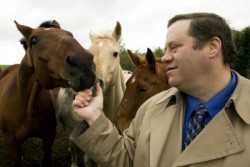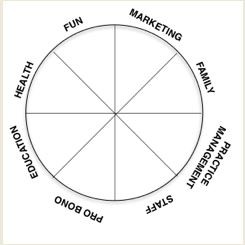To be perfectly frank, I stink at New Year’s resolutions. While my intentions are admirable, most of my resolutions seldom make it past mid January, early February at the latest. So this year, I’m resolving to avoid resolutions altogether and in their place try goal-setting instead. The cool thing is that there is some tech for that — granted it’s a analog device that Buddhists have been using for some 400-odd years, but I have no doubt that someday soon there will be an app for that. It’s called the Bhavacakra (“wheel of life”) and it is a framework for laying out goals.
Step 1 – Identify the important stuff. Thing big picture; what are the 8 things you’d like to tackle this year. If you need some help coming up with ideas – one version of a Bhavacakra is pictured below. Think of these big picture items as forming the rim of the wheel.
Step 2 – Create a few aspirations to go under these big picture categories. Aspirations are your answers to questions like: I want to develop more…, I want to learn…, I want to try to… There should be at least one aspiration for each of your big picture items – but a many to one mapping works too, just remember not to bite off more than you can chew, after all you only have 365 days to work with. For our example, aspirations might be “I want to develop more clients” which maps to “marketing”, or “I want to be more mindful in my practice” which maps to “health”. These form the spokes of the wheel and are usually where most New Year’s resolution stop.
Step 3 – Develop measurable, manageable goals with timelines that will meet each of your aspirations. These fill the sections of the wheels. Goals need to be measurable so you can track your progress, need to be manageable so you don’t get overwhelmed and they should have a time line so there is an impetus to stay on track. The more specific you can make your goals, the better; details are things that can be tracked, measured and managed
The only thing left is to left to do is to execute your goals and the best way to do that is to find away to keep yourself accountable for them. This can range from blogging about your progress to finding an accountablity partner – someone to check in with on a regular basis and who’ll help keep you on track. The key is to find a process you are comfortable with and to go with it. Personally, I use a system of rewards to keep me on track (meet a milestone, get a treat – I find old Scotch and fine chocolate work well as). It’s basically operant conditioning without the electroshocks. If you want a bet of a technological edge, there are goal tracking apps out there; topping my list are Joe’s Goals, Mindbloom’s Life Game, Goalscape, Lifetick, and Milestone Planner. I would note that most of these could double as project management software as well, so while you are on the road to personal improvement, your practice could become more efficient as well – what a great twofer.
So, here’s to a new year and success in achieving your goals.
Bruce M. Cameron Having decided that going to law school and opening a solo law practice would be a sufficient response to the male midlife crisis, Bruce now practices Collaborative Family Law and Estate Planning in rural Minnesota. When not in the law office, he can be found on his small farm where he and his wife are at the beck and call of a herd of horses, a couple of cats, a few dogs and one extremely spoiled parrot. http://www.rurallawyer.com


